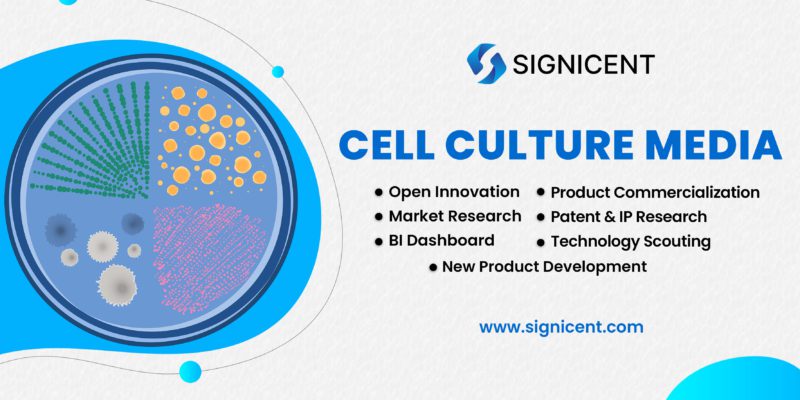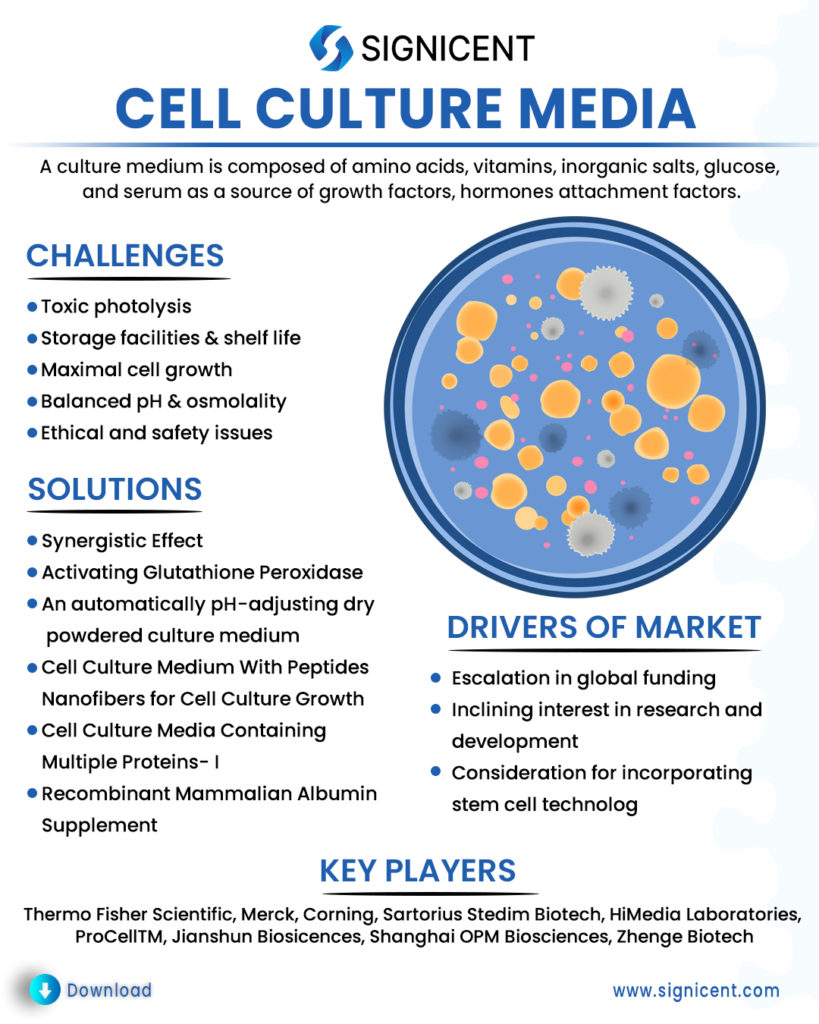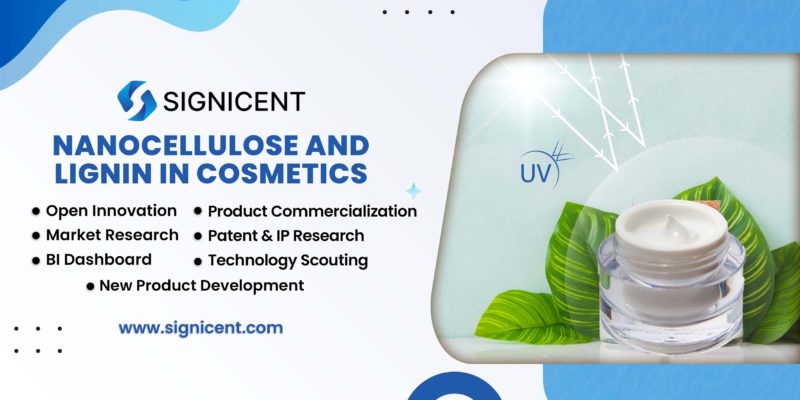The cell culture report sheds light on the cell culture media, challenges, dry cell culture, nanofibers, optimization, and Key Players. The technology scouting on the cell culture revealed solutions to technical challenges, information on industry standards, best practices, & market trends.
A culture medium is composed of amino acids, vitamins, inorganic salts, glucose, and serum as a source of growth factors, hormones attachment factors. An ideal cell culture media usually possess features such as pH, oxygen, carbon dioxide, buffering, osmolality, viscosity, and temperature. A culture medium is used as an additive for reduced-serum or serum-free culture media, for cryopreservation of cells, in electrophoresis, in Western blots, and ELISA applications.
Report on Exploring Cell Culture Media
The cell culture report’s objective is to identify the research, development, and innovations in the field of cell culture media. The report will disclose details of innovations surrounding the composition and emerging technologies for cell culture. Also about the safety aspects of cell culture media along with competitors, key players, and associated technological advancements.
Report on Challenges Related to Cell Culture Media
In this section of the cell culture report, we will discuss the challenges that are related to cell culture media.
Toxic photolysis: Most of the mammalian culture media are composed of riboflavin, tyrosine, and tryptophan. These compounds usually lead to the production of toxic photolysis products within the cell culture media.
Storage facilities & shelf life: Dry powder media production in large volumes requires storage facilities and specialized media kitchens which are necessary to mix and weigh the nutrient components present within the media. Moreover, mixing tanks have to be replaced periodically due to the corrosive nature of dry powder media.
Maximal cell growth: There is an urgent need for a medium containing appropriate amounts of tyrosine and cysteine which would be sufficient enough to support maximal cell growth along with avoiding the problems caused by the limited solubility of tyrosine or the limited stability of cysteine.
Balanced pH & osmolality: There has always been a need to balance the pH and osmolality of the resulting system in which the nutrients are added and to make sure the state of the medium.
Ethical and safety issues: There are safety and ethical considerations associated with the use of animal-derived cell culture media components.
Report on Challenges Associated With Dry Cell Culture Media
The challenges associated with dry cell culture media include toxic photolysis, storage facilities & reduced shelf life of conventional dry powder media.
Innovative Solutions to Overcome the Challenges
An automatically pH-adjusting dry powdered culture medium suited for the growth of animal cells is given. To reduce the stability and shelf-life issues with the conventional media. Larger batch sizes of media can be produced with extended shelf life and media can be easily sterilized. The media is formulated to avoid the toxic photolysis caused by increased concentration of riboflavin, tyrosine, and tryptophan.
Methodology
Steps to formulate powdered cell culture media by spray-drying approach are as followed:
- The dry cell culture contains sodium bicarbonate which does not liberate CO2 upon storage and supports the growth of animal cells upon rehydration.
- The conjugate acid-base pair of buffer salts are added to the dry powdered culture medium which is further aspirated into the apparatus and atomized with a rotary- or nozzle-type atomizer.
- The resultant atomized liquid spray is further mixed with a gas (nitrogen or air) and sprayed into a drying chamber under suitable conditions like optimum temperature and humidity.
- Under these specific conditions, the solvent in the liquid state evaporates in a controlled manner and forms free-flowing particles of the culture medium.
- The powder is made to discharge from the drying chamber and made to pass through filters. Further, the powder is collected for processing such as packaging, sterilization, etc.
Conclusion: The product obtained after the spray drying method was obtained at a reduced inventory, storage, and labor costs. The medium formed also reduces the tendency of getting contaminated which may occur during the pH adjustment process according to standard methods using the traditional dry powder.
The dried cell powder can be stored in low volume with greater shelf life with little need for specialized equipment. The storage quantity is slightly beyond the laboratory scale.
Cell Culture Medium With Peptides
Conventional media have an insufficient amount of tyrosine and cysteine which make them inefficient to support maximal cell growth, thus providing improper pH & osmolarity.
A cell culture medium has six or fewer amino acids in a concentration between 1 g/L to 16 g/L and is serum-free. The cell culture supports cell growth, enhances cell viability and recombinant protein or virus production. The culture medium can be a dry powder or granulated dry powder.
Steps to Prepare Cell Culture Medium
- A peptide having six or fewer amino acids preferably cysteine is taken and combined with another peptide having six or fewer amino acids, preferably tyrosine.
- The above-mentioned compound is combined with carbohydrates and at least one amino acid or salt. Further, the addition of a vitamin, a salt, a buffering agent, an inorganic element, and an animal-origin-free peptide is done.
- Afterward, the combined mixture is added to a fed-batch culture, a bioreactor, or a fermenter to obtain the cell culture medium.
Conclusion: The cell culture medium obtained provides improved stability for culturing of the cells. The medium further provides improved essential conditions required for the growth of the cells. The medium produced is sufficient enough in avoiding the problems caused by the limited solubility of tyrosine or the limited stability of cysteine. The composition thus derived is auto-pH and auto-osmolality balanced.
Nanofibers for Cell Culture Growth
Conventional media is inefficient in exhibiting support for cellular growth.
Nanofibers are emerging materials for providing support for cell growth. The nanofibers greatly improved cellular activity with good biocompatibility. The two-dimensional metal carbides (MXenes) are ideal materials due to their excellent conductivity, outstanding mechanical properties, and large surface area.
Methodology
Titanium carbide (Ti3C2) Mxene composite nanofibers are being produced for cell culture and tissue engineering. The composite nanofibers are fabricated with the help of the electrospinning process and they contained a large number of functional hydrophilic groups further displaying excellent hydrophilicity.
MTT((3-(4, 5-dimethyl thiazolyl-2)-2, 5-diphenyltetrazolium bromide)) method was used to evaluate cellular cytotoxicity and growth on the MXene composite nanofibers. The nano surface and functional groups of nanofibers provide an effective microenvironment for cellular growth.
Conclusion: The technology of nanofibers thus developed can be integrated with other biotechniques also and the unique advantages of MXenes and two-dimensional materials with better performance for biomedical applications, leading to MXene and 2D biomaterials studies.
Each year Signicent provides consultancy to hundreds of organizations to help transform their innovations to value.
Cell Culture Media Containing Multiple Proteins- I
The challenges associated with safety and ethical considerations associated with the use of animal-derived cell culture media components.
Recombinant Mammalian Albumin Supplement
The cell culture media described is supplemented with a plant-produced recombinant mammalian albumin supplement. The growth characteristics of the cultured cells can be improved. The cell culture has high consistency and reproducibility which can be obtained from using a batch of clonal cells.
Synergistic Effect
The invention relates to a cell culture media whose formulation includes a combination of several proteins. The supplement comprises a combination of transferrin-related proteins along with albumin and lactoferrin albumin which yields a synergistic effect on cell growth and productivity.
Activating Glutathione Peroxidase
The recombinant mammalian albumin also comprises rice heat shock protein. Selenium also played a crucial role in the biological systems as it detoxified free radicals by activating glutathione peroxidase. The combination of proteins further could be made out the group consisting of growth factors, lactoferrin, transferrin, insulin, growth hormone, fibronectin attachment factor, lamin attachment factor, collagenase, platelet-derived growth factor, brain-derived neurotrophic factor, glial-derived neurotrophic factor, thymic factors, haptoglobin, lactahedrin, lactoperoxidase, alpha-fetoprotein, immunoglobin, and alpha-lactalbumin along with multiple growth factors.
A detailed method for enhancing the growth of the cells has been disclosed along with the purity level check of the product obtained with the help of SDS-PAGE. The cell culture media is free from the ethical considerations and safety issues associated with the use of animal-derived cell culture media components.
Cell Culture Media Containing Multiple Proteins- II
Learn the methodology for enhancing cell growth. Culturing cells in a culture media with the addition of recombinant mammalian albumin supplement wherein the albumin concentration is 1 EU of endotoxin/mg and less than 2% aggregated albumin.
The plant-produced recombinant mammalian albumin supplement is added to the above-mentioned cell culture media at day 0 of said culturing and further added daily during the said culture.
The recombinant mammalian albumin comprises a minimum of 0.01% wt/wt of rice heat shock protein along with at least 0.04% wt/wt HSP70(rice genes).
The mixture comprises recombinant transferrin-related protein (transferrin) whose ratio to the recombinant mammalian albumin is 1:3 to 1:0.33. The mixture also comprises recombinant transferrin-related protein (lactoferrin) whose ratio to the recombinant mammalian albumin is 1:50 to 1:5000.
The plant-produced recombinant human serum albumin is a seed protein extract from a rice seed of said transgenic rice plant which is again supplemented with rice heat shock protein which is further co-purified from said transgenic rice plant with the plant-produced recombinant human serum albumin.
The plant-produced recombinant human serum albumin has a purity of greater than about 95% when measured by the SDS-PAGE technique.
Enhancing the PCR Efficiency
In this section of the cell culture report, the experts of Signicent have found the methods and formulations that can enhance PCR efficiency.
PCR has always been a powerful tool to obtain sufficient DNA from scarce DNA resources. Metal-organic framework materials(MOFs) have a high specific surface area, tunable pore sizes, alterable surface charges, and favour thermal conductivity. Two such metal-organic framework materials(UiO-66 and ZIF-8) were used to optimize error-prone two-round PCR.
The study proved both the MOFs enhanced the sensitivity and efficiency of first and second-round PCR. The MOFs also widened the annealing temperature range of the second-round PCR.
In the presence of UiO-66 or ZIF-8, obvious target bands were detected even at a template concentration as low as 0.125 μg L−1. Further, it can be mentioned that UiO-66 showed much better PCR efficiency than ZIF-8 at special and lower template concentrations from 0.125 to 0.5 μg L−1.
It could be hence proved with the help of DVtarget band that UiO-66 and ZIF-8 could increase the PCR efficiency by about 39- and 23-fold compared to conventional PCR respectively.
It could be further inferred that DNA polymerase is immobilized by UiO-66 or ZIF-8 materials, and the efficiency of DNA polymerase is improved greatly, leading to the improved PCR effect.
The Future Of Market: Underlying Factors
An escalation in global funding is laying down the foundation for a very promising future. Another significant factor is inclining interest in research and development in the Life-Science industry. Revolution in the technology of biosimilar, biologics, and, recombinant protein products is driving the market. In addition to the aforementioned factors, thriving consideration for incorporating stem cell technology further is taking the market of cell culture to greater heights.
Resolute market growth is driven by the rising need for monoclonal antibodies, growing emphasis on personalized medicine, increasing prevalence of infectious diseases, rising investment in research & development of innovative cell culture products, and rising awareness about vaccines based on cell culture, and high demand for single-use technologies.
Key Players of The Market
It is advisable to look at the key players in the cell culture media to understand the business strategies. The key players of the industry include Thermo Fisher Scientific, Merck, Corning, Lonza, Cytiva, Fujifilm, Sartorius Stedim Biotech, HiMedia Laboratories, ProCellTM, Jianshun Biosicences, Shanghai OPM Biosciences, Zhenge Biotech.
Recent Report



